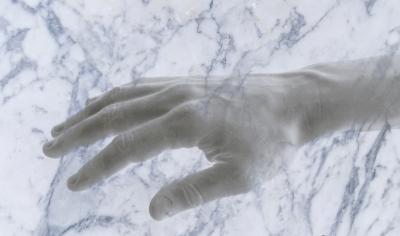This news release is available in German.
The study was published in the international scientific journal PLOS ONE on 13 March 2014.
To induce an illusory perception of the material properties of the hand, a group of neuroscientists from Bielefeld University, the Max-Planck Institute for Biological Cybernetics (Germany), and the University of Milano-Bicocca (Italy) asked volunteers to sit with their hands lying on a table in front of them. They repeatedly hit the participants' right hands gently with a small hammer while replacing the natural sound of the hammer against the skin with the sound of a hammer hitting a piece of marble. Within minutes, hands started feeling stiffer, heavier, harder, less sensitive, and unnatural. Moreover, when approached by a threatening stimulus (a needle that the experimenter moved near their hands), participants showed an enhanced Galvanic skin response, thus demonstrating increased physiological arousal.

As if one's hand were made of marble: Bielefeld neuroscientists successfully deceive participants about their body perceptions.
(Photo Credit: Senna & Parise)
To perceive our bodies and the world around us, our brains constantly combine information from different senses with prior knowledge retrieved from memory. However, unlike most bodily properties that frequently change over time (such as posture and position), our body material never changes. Hence, in principle, it would be unnecessary for the brain to constantly try to infer it.
This novel bodily illusion, the 'Marble-Hand Illusion', demonstrates that the perceived material of our body, surely the most stable attribute of our bodily self, can quickly be updated through multisensory integration. What is more, it shows that even impact sounds of non-biological materials – such as marble and metal – can be attributed consistently to the body, as if its core material could indeed be modified. This surprising perceptual plasticity might help to explain why tools and prostheses can merge so easily into our body schemas despite being made of non-biological materials.
This multisensory perception study is part of the research being carried out at the Department of Cognitive Neuroscience in the Faculty of Biology. The department is one of 40 research groups that are working at the Center of Excellence Cognitive Interaction Technology (CITEC).
Source: University of Bielefeld